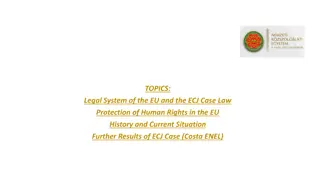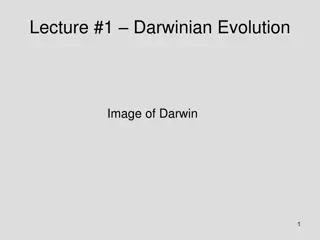Evolution of Human-Environment Relationship Through History
The evolution of human-environment relationships can be traced through four key stages - from hunting and food gathering in early human history to the modern era of science, technology, and industrialization. Each phase reflects changing attitudes towards nature and resource utilization, highlighting the gradual impact of human activities on the environment over time. This historical perspective sheds light on how human actions have increasingly disrupted ecological balance and shaped our interactions with the natural world.
Download Presentation

Please find below an Image/Link to download the presentation.
The content on the website is provided AS IS for your information and personal use only. It may not be sold, licensed, or shared on other websites without obtaining consent from the author.If you encounter any issues during the download, it is possible that the publisher has removed the file from their server.
You are allowed to download the files provided on this website for personal or commercial use, subject to the condition that they are used lawfully. All files are the property of their respective owners.
The content on the website is provided AS IS for your information and personal use only. It may not be sold, licensed, or shared on other websites without obtaining consent from the author.
E N D
Presentation Transcript
4thSemester Paper-4016 ENVIRONMENTAL GEOGRAPHY AND DISASTER MANAGEMENT
HUMAN ENVIRONMENT RELATIONSHIP:HISTORICAL PROGRESSION The study of changing relationships between man and environment in historical perspective may help in demonstrating the increasing adverse impacts of human activities on the environment. The changing relationships of man with the natural environment from prehistoric to modern periods may be divided into Four stages as given below : 1. Period of hunting and food gathering 2. Period of animal domestication and pastoralism 3. Period of plant domestication and agriculture 4. Period of science, technology and industrialization
1. Period of hunting and food gathering This period is related to most primitive man when he was basically a part of natural environment his function was like other animals. Thus the primitive man was functionally a biological man or physical man because his basic requirements were confined to food only which he could collect from his surrounding. The relationship between man and the environment was very friendly, cordial and sweet. The natural environment provided all requirements of early man (food and shelter) and thus man was totally dependent on his environment.Though even early man used to derive resourcesfrom the nature (only food) but this did not make anychange in the natural environment because only fruits were used.
With the march of time man learned to hunt animals for his food. This led to first attempted intentional step of man in the exploitation of natural resources. Even the hunting of animals did not make any change in the natural environmental system because of his limited requirement and very low population and unorganized society. The discovery of fire made a significant change in the attitude of man because now he learned to cook animal flesh before eating. This practice required wood which he used to derive easily from the forest. Thus,the discovery of fire and invention of tools and weapons made the man capable of exploiting natural resources from the forest,through fruit gathering and animal hunting
The first destruction of environment started with inadvertent burning of forests due to carelessness of man while cooking and roasting the animals with fire. This led to a chain of effects by man on his environment. 2.Period of animal domestication and pastoralism With the march of time early man learned to domesticate animals for his own benefits. He might have domesticated some milch cattle and some animals for meat in the beginning. Slowly his herd of domesticated animals might have increased. man used to burn forest to create temporary home for the domesticated animals, to exploit forest resources to gather fodder for his animals and food for himself. .
Domestication of animals might have also given birth to group or community life among the early people in order to protect their animals and themselves from wild animals. This increase in the population of domesticated animals also led to increase in the population of early people which ultimately led to meaningful exploitation of environmental resources. This could not change the natural state of the environment because the population of early people and their domesticated animals was still under manageable size and the changes brought in by human activities in the environment were well within the limit of self-regulatory mechanism of the natural environmental system/ecosystem
3.Period of plant domestication and agriculture Domestication of plants initiated primitive type of agriculture and sedentary settled life of people who previously were nomads and wanderers. But still many of the people used to live nomadic life. Thus the emergence of socially organized human communities, human civilization and farming practices changed the existing almost friendly and cordial relationships between man and his natural environment. People also moved from the area of greater concentration (of people) to other areas in search of new fertile land. This led to spread of human population and thus destruction of natural ecosystem. Shifting or jhuming cultivation, which was most prevalent form of primitive cultivation, was responsible for more destruction of natural forest
It may be pointed out that,many new elements of cultural environment were evolved through various stages of agricultural development upto 1750 or say before industrial revolution. All these could be possible because of development in technologies which changed the physical and social man into economic man which led to the phase of industrialization but in the beginning no serious damage was done to the natural environment though significant changes, no doubt, were brought in the environment. Though man became successful in transforming the natural environmental resources in his way but the nature was still supreme and master and man continued to be guided by physical environment.
4.Period of science, technology and industrialization The dawn of industrial revolution in late nineteenth century (precisely since 1860 A.D.) with the emergence of science and development of more efficient and sophisticated technology initiated the hostile relationship between man and his natural environment. Advanced technologies and scientific techniques of the modern technological man led to reckless and indiscriminate rapacious exploitation of natural resources for industrial expansion and urban growth which have altogether created most of the present day environmental and ecological problems of global dimension.
The impacts of modern technological man on natural environment are varied and highly complex as the transformation or modification of one natural condition and process leads to a series of changes in the biotic and abiotic components of the biospheric ecosystems. Thus if we look at the historical progression of man- environment relationships it become clear that purely natural relationship between physical primitive man and natural environment during prehistoric period has changed to hostile relationship between technological man and the environment at present.This substantial change and shift in the nature and magnitude of man s interactions with the natural environment has given birth to numerous environmental problems of serious consequences because the changes effected by man in the environment have become adjustable by the in-built self- regulatory mechanism of the natural environmental system / ecosystem.























